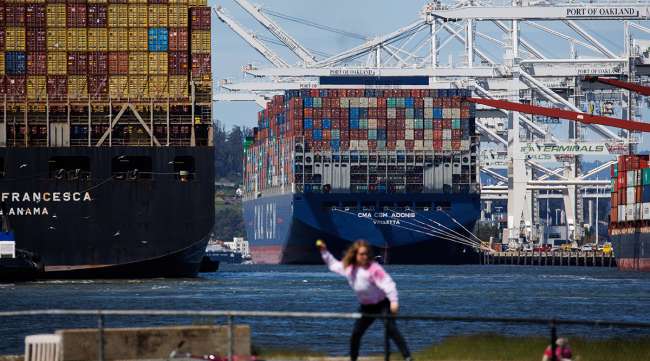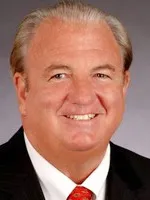Bay Area News Group
Port of Oakland Has a Problem, and Its Name is Mud

[Stay on top of transportation news: Get TTNews in your inbox.]
At the Port of Oakland on a recent weekday, trucks, cranes and container-laden ships moved goods across the sprawling 1,300-acre complex with the precarious precision of a Rube Goldberg machine.
Mere blocks from downtown Oakland, the port operates essentially as a city within a city. It’s the ninth-biggest port in the country and the first stop for 99% of containerized goods moving through Northern California.
In the whir of logistics and machinery, it’s easy to forget that everything happening here is made possible by one unsung, unglamorous and Sisyphean task: hauling mud from San Francisco Bay.
That dredging process has enormous implications for the future of shipping and transportation in the Bay Area, and may hold the key to protecting local shorelines.
“The bottom line is that if we don’t dredge, none of this happens,” said port spokesperson Robert Bernardo, looking out over stacks of containers. “Period.”
San Francisco Bay has long been known as one of the world’s best-run and largest natural harbors. It’s one of the primary reasons that the Bay Area has become the metropolitan area it is today. But in the era of modern shipping, one of the natural features of the bay has posed a growing challenge — although an enormous protected harbor, it is mostly shallow. Its average depth is about 12 feet, only slightly deeper than a swimming pool. Containerships require water at least 30 feet deep, if not more.
Dredging solves that problem.
Every year in the summer and fall, 3 million to 6 million cubic yards of sediment are removed from the floor of the bay to make room for ships to travel. Enormous excavators hung off the side of dredging scows drag silt up from the bay floor to create underwater pathways for our Pelotons, couches and televisions.
For the past 20 years, the process of disposing of all that extra mud has been governed by what agencies refer to as the “40-40-20” split. Over the course of five years, 40% of the mud dredged from the bay is dumped into the Pacific Ocean, 40% is designated for “beneficial reuse,” such as restoring wetlands, and 20% is disposed of elsewhere in the bay.
In recent years, agencies have started to rethink the math.

Coleman
“That was an old paradigm. It served us well,” said John Coleman, the CEO of the Bay Area Planning Coalition, a local nonprofit focused on sustainable industry. “But when they developed it years ago, climate change wasn’t on the mind of anybody.”
The Pacific was an easy dumping ground. For a long time, dumping sediment in the bay was the cheapest and safest way to get rid of it. By the 1980s, a hundred years of industry filled the bottom with toxins.
But as climate change accelerates sea level rise, erosion and flooding, there’s a growing understanding that the Bay Area needs as much sediment as it can get.
A recent report by the San Francisco Estuary Institute and the Aquatic Science Center estimated that the Bay’s wetlands, which serve as the region’s first line of defense against flooding, will need more than 450 million cubic yards of sediment between now and 2100 “just to maintain what we currently have.”
The same study estimated that over $100 billion of economic assets are at risk of flooding over that same time period.
With such a shortfall of sediment, and so much at risk, experts have turned to an obvious candidate to protect our shorelines: dredged sediment. It’s estimated that changing the dredging disposal paradigm could provide as much as 60% of that shortfall. Dredged sediment is already being used to restore natural habitat such as the Montezuma Wetlands near Suisun City.
Still, repurposing the mud for shoreline protection is easier said than done. The 40-40-20 split was established in a long-term management plan in 2001. The Army Corps of Engineers, a federal agency that manages most of the dredging in the bay, prioritizes minimizing its costs above all else. Federal agencies are notoriously slow-moving.

Kayne Grau, CEO of Uptake, discusses ways that fleets can use data to prevent expensive truck repairs. Hear the program above and at RoadSigns.TTNews.com.
“We are in a scenario where there’s a desire to do more beneficial reuse, but much of the material is still being dumped into the ocean because it’s cheaper,” said Ian Wren, a staff scientist with San Francisco Baykeeper, a local environmental nonprofit.
For regional ports, there is, quite literally, an even bigger problem on the horizon. Every year, ships are getting bigger and bigger. The MSC Arina, part of a new generation of megaships, is a quarter-mile long and requires water at least 52 feet deep. To turn around in a narrow channel like the Port of Oakland, it needs larger and deeper turning basins.
“We’re seeing ships getting longer, wider, ships increasing in size,” said Edwin Draper, a Port Supervising Engineer at the Port of Oakland. “It’s definitely more challenging to maneuver in tight spaces. These turning spaces are almost like a cul-de-sac.”
In preparation for these larger ships, the port has begun studying how to deepen and widen its turning basins for larger and larger ships. They’re currently in the feasibility stages of the project, but it’s unclear if the project will ever come to fruition. Nearby residents have expressed concern about air quality and safety with additional trucks and traffic. It’s unclear exactly where funding for the project would come from.
“We need to have a reality check,” Coleman said. “If we don’t dredge to the adequate depths and width to wider ships coming in, those ships will go elsewhere. With that goes thousands of jobs, millions of dollars of taxable revenue.”
For both Oakland’s port and shoreline restoration, it is finances, rather than political will, that serves as the primary hangup. Whereas other coastal states supply an annual allocation to dredging, the state of California contributes no such money — instead relying exclusively on federal funding to dredge shipping channels.
Nor is there money allocated to restoration work. It’s hard to get people to care about mud.
“We’d love to see the state of California have a budget line saying we’re going to have money for beneficial reuse because we care about wetlands,” said Brenda Goeden, the Sediment Program Manager at San Francisco Bay Conservation and Development Commission. “But we’re not there yet.”
For now, both the ports and Bay Area shorelines are making do. But if the Rube Goldberg machine is to continue to function, Coleman believes that may need to change.
“We tend to operate in an emergency mode,” Coleman said. “But we need to fix this before it’s too late.”
Want more news? Listen to today's daily briefing below or go here for more info:
Distributed by Tribune Content Agency, LLC

